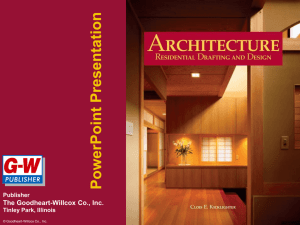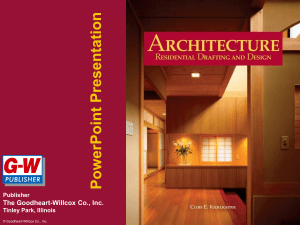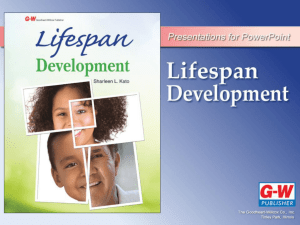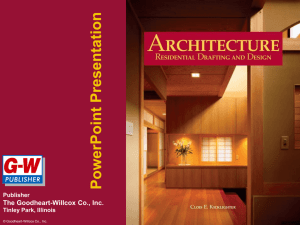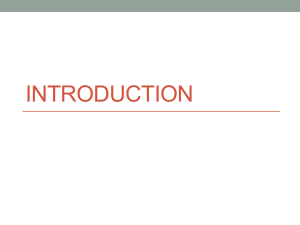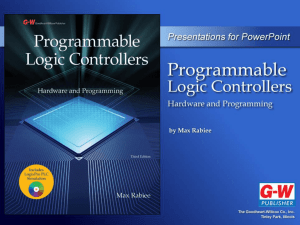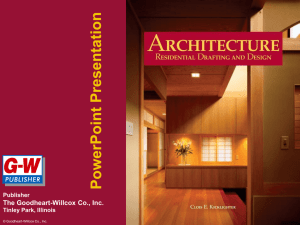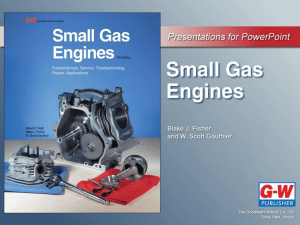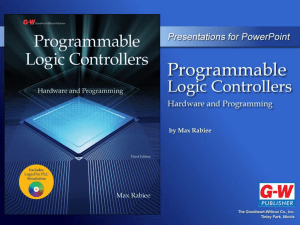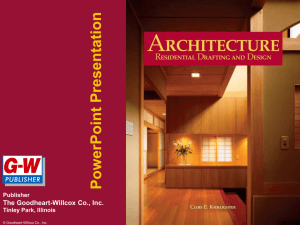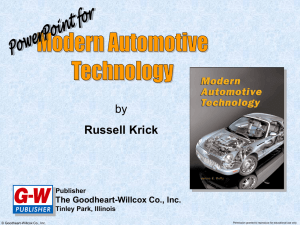Chapter 6 - Washington County Public Schools
advertisement
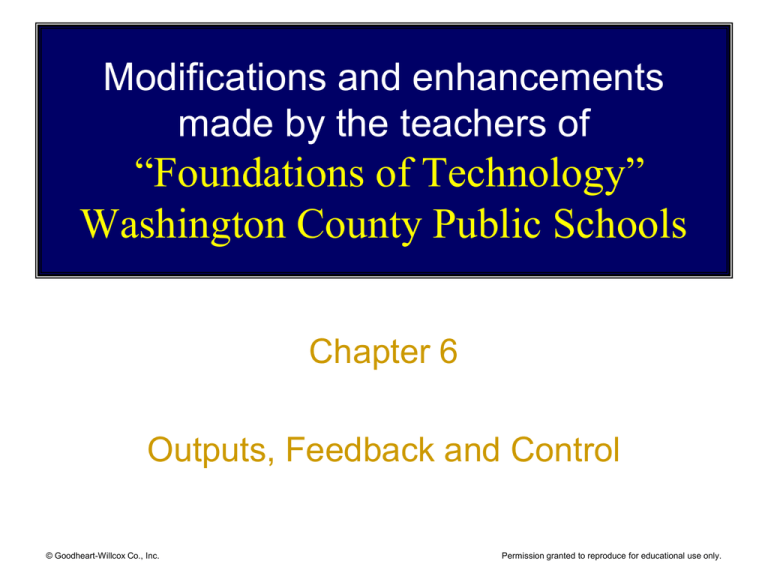
Modifications and enhancements made by the teachers of “Foundations of Technology” Washington County Public Schools Chapter 6 Outputs, Feedback and Control © Goodheart-Willcox Co., Inc. Permission granted to reproduce for educational use only. Most PowerPoint's include in the following order: • Suggestions - suggestive engagement activities / project for the chapter • Voluntary State Curriculum objectives met within this chapter and pages of the book that correlate to these objectives. • The long term objective for the course. The short term objective “Big Idea” for this chapter. Qualifier for learning the stated objectives. • Lesson Procedures • Warm Up – Timed Daily Reading – Timed Objectives to be written © Goodheart-Willcox Co., Inc. • Introduction of an Academy or CTE Program • Lesson (to include learner engaging activities) – Higher Order questioning – Timed group activities • Place where you can work in Washington County with the skills learned in this chapter • Review of Career • Closure (exit ticket) – Review of Objectives – Homework Assignment – Study foundationsoftechnology.com Permission granted to reproduce for educational use only. Suggestions • See document on teacher website © Goodheart-Willcox Co., Inc. Permission granted to reproduce for educational use only. Voluntary State Curriculum Chapter 6 VSC Term Pages in Text Book 1.B Develop an understanding of the core concepts of technology 1.C Develop an understanding of the relationship among technologies and the connections between technology and other fields of study. 2.B Develop an understanding of the cultural, social, economic, and political effects of technology 105-109 2.B.1 Explain that changes in society caused by the use of technology can range from gradual to rapid and from subtle to obvious 107-109 2.B.2 Explain that decisions about the use of technology involve trade-offs between positive and negative effects. 105-106 2.B.5 Explain situations where technological development has magnified the inequities among peoples and societies 105-107 2.B.6 Justify the contention that individual citizens have to make informed decisions about the development and use of technology. 105-107 2.C Develop an understanding of the effects of technology on the environment 111-113 2.C.4 Research and report on processes (reusing, reducing, and recycling) that 111-113 conserve water, soil, and energy Permission granted to reproduce for educational use only. © Goodheart-Willcox Co., Inc.y 109-118 108 Voluntary State Curriculum Chapter 6 VSC Term Pages in Text Book 2.D Develop an understanding of the role of society in the development and use of technology 104 2.D.1 Analyze how different cultures develop their own technologies to satisfy their individual and shared needs, wants and values 104 3.D.3 Select and use tools and instruments in the testing and evaluation of design solutions. 4.E.3 Identify and describe how various types of electric circuits (i.e., series and parallel) provide a means of transferring and using electrical energy to produce heat, light, sound, as well as chemical changes. 4.H Analyze the functioning and applications of fluid technology systems. 4.H.1 Identify and describe application of fluid technology in the designed world. Such as: Air pumps, Water Pumps, Automobile brakes, airfoils 115 5.E Develop an understanding of information and communication technologies 361 109-119 108 Explain that there are many ways to communicate information, such as 361 graphic and electronic means. © Goodheart-Willcox Co., Inc. Permission granted to reproduce for educational use only. 5.E.5 Objectives • Over Arching (Long Term) Objective (s) … – The students will develop a basic understanding of the design world. – How would an improved technical awareness improve one’s life? • This chapters “Essential Question, Big Idea” – Why are after production systems needed in product development? • Students will be able to answer the daily objectives within this PowerPoint to a 70% degree of efficiency. © Goodheart-Willcox Co., Inc. Permission granted to reproduce for educational use only. Technology Resources Teacher Computer, Projector, White board, Student Computers, Name Randomizer, Timer, www.foundationsoftechnology.com, .foundationsoftechnology.com/worldsbestfotteachersareinwcps Materials Handouts, Project Materials Lesson Plan Instructional Procedures and Content Notes Silent Reading (7 minutes) – Slide is automatically timed Write Objectives (5 minutes) – Students write daily objectives in their notebooks. Leaving enough room to write the answers to the objectives at the end of class / Slide is automatically timed (Song may play to tie into the objectives) Chapter PowerPoint (35 minutes, approximately can go much longer or shorter) Teacher conducts interactive lecture with a PowerPoint slideshow while students take fast notes and participate in higher order questioning, and small group activities. PowerPoint also includes short video clips & web links. Desk Activity (10 minutes, Approximately) Vocabulary Students write each word multiple times and define each word. Test Your Knowledge Students answer designated summary questions for the chapter. Study with the FoundationsofTechnology.com website Projects / Computer Activity (28 minutes Approximately) Closure (Review of 5 minutes, Objectives Approximately) Homework: (if applicable) Finish Vocabulary / Objectives / Test Your Knowledge Study with the FoundationsofTechnology.com website Modifications to meet student needs (IEP, ILP, ELL and Special Needs) Students with writing difficulties may write the objectives later. Slower students will be accommodated by being given the complete set of notes and ask to underline the key words other students are writing down. Slide shows are equipped to click on voice over buttons (created by advanced students,) so the slide show can be read to those who need it on an individual basis. Modifications to meet student needs (Enrichment) Advanced students improve the PowerPoint lectures for various chapters. They add voice over, modify pictures, find movie clips, website links, etc, and can chose from a list of independent project challenges. Sources: Include electronic and printed materials as well as acknowledgement of any influence or guidance provided in the development of the lesson: Wright, R. Thomas. (2008). Technology. Illinois: The Goodheart-Willcox Company, Inc. © Goodheart-Willcox Co., Inc. Permission granted to reproduce for educational use only. PowerPoint Presentations for Technology By R. Thomas Wright The Goodheart-Willcox Company, Inc. Tinley Park, Illinois www.g-w.com © Goodheart-Willcox Co., Inc. Permission granted to reproduce for educational use only. Section 2 Technological System Components © Goodheart-Willcox Co., Inc. Permission granted to reproduce for educational use only. Chapter 6 Outputs and Feedback and Control Read Pages 104-109 Day 1 © Goodheart-Willcox Co., Inc. Permission granted to reproduce for educational use only. Copy The Following Big Idea “Why is an after production system needed in product development?” & Objectives 1. What effect do feedback and control have on outputs in technological systems? 2. How are outputs categorized? 3. What are the desirable and undesirable outputs of transportation technology? 4. Define feedback as used in technology systems. © Goodheart-Willcox Co., Inc. Permission granted to reproduce for educational use only. Copy The Following Objectives 1. What effect do feedback and control have on outputs in technological systems? 2. How are outputs categorized? 3. What are the desirable and undesirable outputs of transportation technology? 4. Define feedback as used in technology systems. © Goodheart-Willcox Co., Inc. Permission granted to reproduce for educational use only. Chapter 6 Outputs and Feedback and Control Read Pages 109-119 Day 2 © Goodheart-Willcox Co., Inc. Permission granted to reproduce for educational use only. Copy The Following Objectives 5. What are the major types of internal control systems? 6. What are the components of internal control systems? 7. Name a few types of monitoring devices. 8. Define manual and automatic control systems. ManualAutomatic9. What are a few external controls? © Goodheart-Willcox Co., Inc. Permission granted to reproduce for educational use only. Copy The Following Objectives 5. What are the major types of internal control systems? 6. What are the components of internal control systems? 7. Name a few types of monitoring devices. 8. Define manual and automatic control systems. ManualAutomatic9. What are a few external controls? © Goodheart-Willcox Co., Inc. Permission granted to reproduce for educational use only. Day 1 Outputs and Feedback and Control © Goodheart-Willcox Co., Inc. Permission granted to reproduce for educational use only. The Technological System © Goodheart-Willcox Co., Inc. Permission granted to reproduce for educational use only. Outputs • The desirable outputs of technological systems satisfy a technological problem or opportunity. • There can also be undesirable outputs, however, like pollution, soil erosion, or other problems. • The intended outputs are expected and may be desirable or undesirable. • Unintended outputs, which were not expected, may also result from systems. © Goodheart-Willcox Co., Inc. Permission granted to reproduce for educational use only. Immediate and Delayed Outputs • Most technological systems are designed to produce a product or service for use now, which results in immediate outputs. • Aerosol cans and sulfur dioxide eventually creating pollution are examples of delayed outputs. © Goodheart-Willcox Co., Inc. Permission granted to reproduce for educational use only. Feedback and Control • We can view internal control systems from three different angles: – Types of control systems. – Components of control systems. – Operations of control systems. • There are also external controls, such as political actions and personal value systems, to be considered. © Goodheart-Willcox Co., Inc. Permission granted to reproduce for educational use only. Class Work • Answer Objectives # 1-4 • Test Your Knowledge - Page 120 # 1-5 • Work on projects • Four Students to Answer Objectives • Timer • Homework - Vocabulary & Unfinished Work © Goodheart-Willcox Co., Inc. Permission granted to reproduce for educational use only. Review What effect do feedback and control have on outputs in technological systems? Outputs are the results of the system that are, in turn, modified or corrected by feedback and control. © Goodheart-Willcox Co., Inc. Permission granted to reproduce for educational use only. Review How are outputs categorized? Outputs are categorized in three ways: desirable/undesirable, intended/unintended, and immediate/delayed. © Goodheart-Willcox Co., Inc. Permission granted to reproduce for educational use only. Review What are the desirable and undesirable outputs of transportation technology? The desirable output is the movement of goods and people, while the undesirable output is the fumes and toxic by-products of different modes of transportation. © Goodheart-Willcox Co., Inc. Permission granted to reproduce for educational use only. Review Define feedback as used in technology systems. Using information from the output of a system to control or regulate the system or its inputs to affect the output. © Goodheart-Willcox Co., Inc. Permission granted to reproduce for educational use only. Day 2 Outputs and Feedback and Control © Goodheart-Willcox Co., Inc. Permission granted to reproduce for educational use only. Types of Control Systems • Two major types of control systems used: – Open-loop control and closed-loop control. • Open-loop systems use no feedback. • More systems use closed-loop systems, which means these systems use feedback. • Technology systems, such as manufacturing, use market research, quality control, inventory control, process control, material resource control, and wage control. © Goodheart-Willcox Co., Inc. Permission granted to reproduce for educational use only. Components of Control Systems • Monitoring devices include: – Mechanical sensors, thermal sensors, optical sensors, electrical or electronic sensors, and magnetic (electromagnetic) sensors. • Data-comparing devices like: – Analytical systems and judgmental systems. • Adjusting devices are controllers. © Goodheart-Willcox Co., Inc. Permission granted to reproduce for educational use only. Adjusting Devices • Four adjusting devices: – Mechanical controllers: cams, levers, and other linkages. – Electromechanical controllers: electromagnetic coils and forces to move linkages. – Electrical and electronic controllers: switches, transistors, and integrated circuits. – Fluidic controllers: fluids and air. © Goodheart-Willcox Co., Inc. Permission granted to reproduce for educational use only. The Operation of Control Systems • Technological control systems can be classified as: – Manual control systems like systems that pilots would use. – Automatic control systems like thermostats in heating systems. © Goodheart-Willcox Co., Inc. Permission granted to reproduce for educational use only. External Controls © Goodheart-Willcox Co., Inc. Permission granted to reproduce for educational use only. Effects of Control Systems © Goodheart-Willcox Co., Inc. Permission granted to reproduce for educational use only. Discussion Do public opinions and laws govern technological actions? In what way? © Goodheart-Willcox Co., Inc. Permission granted to reproduce for educational use only. Career Corner • Dental hygienists. – Examine patients’ teeth and gums and record the presence of diseases. – Use a variety of tools and machines, including instruments to clean teeth and X-ray machines to take dental pictures. – Must graduate from an accredited dental hygiene school and pass a written and clinical examination. American Dental Hygienists © Goodheart-Willcox Co., Inc. Permission granted to reproduce for educational use only. Class Work • Answer Objectives # 5-9 • Test Your Knowledge - Page 120 # 6-10 • Work on projects • Five Students to Answer Objectives • Timer • Homework - Vocabulary & Unfinished Work © Goodheart-Willcox Co., Inc. Permission granted to reproduce for educational use only. Review What are the major types of internal control systems? Open-loop control and closed-loop control. © Goodheart-Willcox Co., Inc. Permission granted to reproduce for educational use only. Review What are the components of internal control systems? Monitoring devices data-comparing devices, and adjusting devices. © Goodheart-Willcox Co., Inc. Permission granted to reproduce for educational use only. Review Name a few types of monitoring devices. Mechanical, thermal, optical, electrical and electronic, and magnetic (electromagnetic) sensors. © Goodheart-Willcox Co., Inc. Permission granted to reproduce for educational use only. Review Define manual and automatic control systems. Automatic control systems: systems that can monitor, compare, and adjust a system without human interference. Manual control systems: systems that require humans to adjust the process. © Goodheart-Willcox Co., Inc. Permission granted to reproduce for educational use only. Review What are a few external controls? Consumers, environmentalists, politicians, church leaders, or foreign competitors. © Goodheart-Willcox Co., Inc. Permission granted to reproduce for educational use only.
